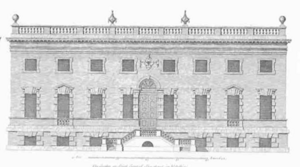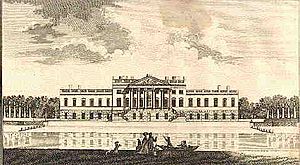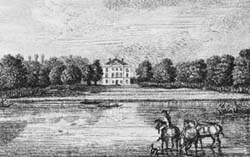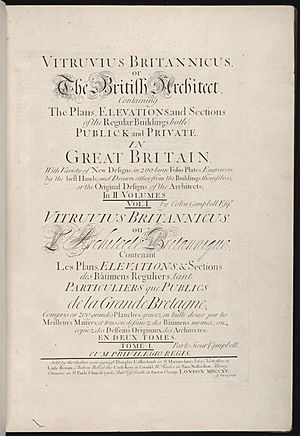Colen Campbell facts for kids
Quick facts for kids
Colen Campbell
|
|
|---|---|
| Born | 15 June 1676 |
| Died | 13 September 1729 |
| Resting place | Westminster Abbey |
| Nationality | Scottish |
| Occupation | Architect |
| Buildings | Mereworth Castle Stourhead Houghton Hall Burlington House Wanstead House |
Colen Campbell (born June 15, 1676 – died September 13, 1729) was an important Scottish architect and writer. He is known for helping to create the Georgian style of buildings. He lived in Italy and England for most of his life. Besides his building designs, he is famous for his books, Vitruvius Britannicus. These books had amazing pictures of the grand houses of his time.
Contents
Early Life and Training
Colen Campbell came from the famous Campbell family, linked to Cawdor Castle. He likely graduated from the University of Edinburgh in 1695. He first studied to be a lawyer.
Between 1695 and 1702, he traveled in Italy. He probably signed the visitor's book at the University of Padua in 1697. It is thought that he learned about architecture from James Smith. Campbell even owned many drawings of buildings designed by Smith.
Vitruvius Britannicus: His Famous Book
Colen Campbell's most important published work was Vitruvius Britannicus, or the British Architect.... It came out in three books between 1715 and 1725. This was the first major architecture book from England in a long time.
The books were like a catalog of designs. They contained detailed pictures of English buildings by famous architects like Inigo Jones and Sir Christopher Wren. They also showed designs by Campbell himself and other leading architects.
In the introduction, Campbell wrote about how he disliked the "over-the-top" Baroque style. He wanted British architecture to be unique and not just copy foreign styles. He dedicated his first book to King George I. The third book (1725) also showed grand designs for gardens and parks. These designs featured straight paths and patterned flowerbeds.
The books showed buildings from different angles: their floor plans, how they looked inside, and their outside appearance. The success of these books helped make the neo-Palladian architecture style very popular. This style became well-known in Great Britain and America during the 1700s. For example, a picture of Somerset House from Vitruvius Britannicus inspired American architect Peter Harrison. He used it when he designed the Brick Market in Newport, Rhode Island, in 1761.
Campbell was influenced by James Smith, a top Scottish architect. Campbell called Smith "the most experienced architect" in Scotland.
The books were very well-timed. They came out when many new country houses and villas were being built. Wealthy families, especially the Whigs, were eager for new designs. Campbell quickly gained the support of Lord Burlington. Burlington even replaced another architect, James Gibbs, with Campbell at Burlington House in London. This helped Campbell become a central figure in English neo-Palladian architecture.
Colen Campbell's Main Buildings
- Wanstead House, Essex, built around 1713–1720. In his first Vitruvius Britannicus book, Campbell showed two designs for this grand house. The second design was already being built when the book came out. Campbell claimed Wanstead House had Great Britain's first classical portico (a porch with columns). However, this honor probably belongs to The Vyne in Hampshire.
- Burlington House, London, 1717. Campbell redesigned the front of this building. He also created an entrance gateway for Richard Boyle, 3rd Earl of Burlington. (The building was changed again in 1868, and the gateway was removed.)
- Stourhead, Wiltshire, 1721–1724. This house was built for Henry Hoare, a banker from London. Wings were added later in the 1700s. Campbell's portico was not built until 1841, though it followed his design. The famous garden around a lake was created after Campbell's death.
- Pembroke House, Whitehall, London, 1723. This house was for Henry Herbert, 9th Earl of Pembroke. It was in a very important location in London. Lord Herbert was inspired by it to design Marble Hill House in Twickenham. Marble Hill was for Henrietta Howard, Countess of Suffolk, who was the mistress of the future King George II.
- Houghton Hall, Norfolk, started in 1722. This house was built for Sir Robert Walpole, who was a very important politician. Campbell was one of several architects who worked on this building.
- Mereworth Castle, Kent, 1722–1725. This is Campbell's most clearly Palladian design. It was based on the famous Villa La Rotonda in Italy. It has a large dome with no base, and 24 chimney flues go up through it to the top.
- Waverley Abbey House, Surrey, around 1723–1725. This house was built for John Aislabie. It has been changed a lot since then.
- Nos 76 and 78 Brook Street, London W1, 1725–1726. No. 76, which still stands, was Campbell's own house. The designs for its inside were published in his book Five Orders of Architecture (1729). It has a blue plaque that remembers him.
- Compton Place, Eastbourne, Sussex, from 1726 onwards. Campbell rebuilt the south front and made many changes inside for Sir Spencer Compton.
- Plumptre House, Nottingham, 1724–1730. Campbell remodeled this house for John Plumptre, who was a Member of Parliament.
Other Buildings Designed by Colen Campbell
Here is a list of other buildings Colen Campbell worked on:
- Shawfield Mansion, Glasgow (1712) – torn down in 1792
- Hedworth House, Chester-le-Street (1726)
- Hotham House, Beverley (1716–1717) – torn down around 1766
- Burlington (Ten Acre Close) Estate, London, he planned the layout (1717–1718)
- Rolls House, Chancery Lane, London (1718) – torn down in 1895–1896
- Ebberston Lodge, Ebberston, Yorkshire, including a waterfall (1718)
- Several houses on Great Burlington Street, London (1718–1724)
- Burlington Girls' Charity School, Boyle Street, London (1719–1721)
- Wimbledon Manor House, Surrey (1720) – it's not clear if it was fully finished
- Newby Park, Yorkshire (1720–1721)
- Pembroke Lodge, Whitehall, London (around 1724) – torn down in 1756
- Hall Barn, Buckinghamshire, garden buildings (1724)
- Greenwich Hospital, Greenwich, London; he added to some blocks (1726–1729)
- Hackney House, Hackney, London (around 1727) – torn down before 1842
- Althorp, Northamptonshire, new stables and gate (around 1729–1733)
- Studley Royal Park, Yorkshire, the stables (around 1729) – built after his death by Roger Morris
Images for kids
-
Design for Stourhead in Wiltshire, from Vitruvius Britannicus vol. 3, 1725
-
Houghton Hall in Norfolk; James Gibbs added the domes to Campbell's design












